Multidisciplinary Approach to the Study of Tableware and Common Wares from Early Medieval Tokharistan
Abstract
1. Introduction
2. Materials and Methods
3. Morphological Examination and Chronological Contextualisation
4. Archaeometric Results
4.1. Chemical Analysis
4.2. X-Ray Diffraction Analysis
4.3. Petrographic Analysis
5. Discussion
6. Conclusions
- The examined vessels are mostly made of calcareous pastes, which suggests that tableware and common wares were preferentially crafted with calcareous materials.
- With few exceptions, raw materials are very similar, although from different sources.
- Vessels from Khosijat Tepe, Balalyk Tepe and maybe Dabil Kurgan—excluding the handled goblet KT-Gb1 and the low-calcareous jugs BT-Jg1 and DK-Jg1—could have the same provenance; vessels from Shurob Kurgan could be ascribed to a different production centre, as could jug BT-Jg1 and jug DK-Jg1; and the handled goblet KT-Gb1 could be imported.
Supplementary Materials
Author Contributions
Funding
Data Availability Statement
Acknowledgments
Conflicts of Interest
References
- Baumer, C. The History of Central Asia. In The Age of the Silk Roads; I.B. Tauris: London, UK, 2014; Volume 2. [Google Scholar]
- Solov’ev, V.S. Rannesrednevekovaya Keramika Severnogo Tokharistana; Yelets University: Yelets, Russia, 1996. [Google Scholar]
- Rtveladze, E.V. Gorodishche Shurobkurgan. In Materialy Tokharistankoj Ekspedizii—Arkheologicheskie issledovanija Shurobkurgana; Izdatel’stvo EGU im. I.A. Bunina: Yelets, Russia, 2004; Volume 4, pp. 5–10. [Google Scholar]
- Rtveladze, E.V. Istoriko-geograficheskii i arkhaeologicheskii obzor Pashkhurdskoi doliny. Geograficeskoe mestopolozhenie. In Materialy Tokharistankoj Ekspedizii—Poselenie Dabilkurgan v severnoj Baktrii; Izdatel’stvo EGU im. I.A. Bunina: Yelyets, Russia, 2013; Volume 9, pp. 5–32. [Google Scholar]
- Al’baum, L.I. Balalyk-tepe. K istorii material’noy kul’tury i iskusstva Tokharistana; Izdatel’stvo Akademii Nauk UzSSR: Tashkent, Uzbekistan, 1960. [Google Scholar]
- Solov’ev, V.S. Raskopki na ob’ekte v Dabilkurgana v 2010–2013 gg. In Materialy Tokharistankoj Ekspedizii—Poselenie Dabilkurgan v severnoj Baktrii; Izdatel’stvo EGU im. I.A. Bunina: Yelets, Russia, 2013; Volume 9, pp. 32–81. [Google Scholar]
- Tušlová, P. Systematic Field Survey in South Uzbekistan. Master’s Thesis, Charles University, Prague, Czech Republic, 2012. [Google Scholar]
- Litvinsky, B.A. The Hephthalite empire. In History of civilizations of Central Asia. The Crossroads of Civilizations: A.D. 250 to 750; Litvinsky, B.A., Ed.; UNESCO Publishing: Paris, France, 1996; Volume 3, pp. 138–165. [Google Scholar]
- Bestetti, M.M.; Martínez Ferreras, V.; Gurt Esparraguera, J.M.; Jiménez Salvador, J.L. Early Medieval coarse wares from northern Bactria-Tokharistan. Archeological and archeometric characterization. Archaeol. Res. Asia 2022, 31, 100386. [Google Scholar] [CrossRef]
- Gurt Esparraguera, J.M.; Ariño Gil, E.; Martínez Ferreras, V.; Pidaev, S.R. The Buddhist occupation of Tchingiz Tepe (Termez, Uzbekistan) in the Kushan period through the ceramic contexts. Archaeol. Res. Asia 2015, 3, 19–33. [Google Scholar] [CrossRef]
- Martinez Ferreras, V.; Tsantini, E.; Gurt Esparraguera, J.M.; Pidaev, S.R. Archaeometrical Study of Archaeological Ceramics: Extension of Provenance and Technological Analysis with New Materials from Ancient Termez, Kampyr Tepe and Tchurobkurgan Sites; Gurt Esparraguera, J.M., Pidaev, S.R., Eds.; Preliminary Report of the Work of the International; Pluridisciplinary Archaeological Expedition to Bactria 2009; IPAEB: Barcelona, Spain, 2010; Volume 4, pp. 275–403. [Google Scholar]
- Zavyalov, V.A. Kushanhahr under the Sasanian (on the Results of Excavations of the Zartepa Site); St Petersburg State University: St Petersburg, Russia, 2008. [Google Scholar]
- Mandelshtam, A.M. Pamyatniki kochyevnikov kushanskogo vryemyeni v syevernoy Baktrii. In Trudy tadzhiskoy arkhyelogichyeskoy ekspyeditsii Instituta Arkheologii AN CCCP i Instituta Istorii, VII; Academy of Sciences of USSR: Leningrad, Russia, 1975. [Google Scholar]
- Solov’ev, V.S. Raskopki vtorogo domovladenja. In Materialy Tokharistankoj Ekspedizii—Arkheologicheskie issledovanija Shurobkurgana; Izdatel’stvo EGU im. I.A. Bunina: Yelets, Russia, 2004; Volume 4, pp. 76–117. [Google Scholar]
- Pugachenkova, G.A.; Rtveladze, E.V. (Eds.) Dalverzintepe. Kushanskiy gorod na yugye Uzbyekistana; Academy of Sciences of the Soviet Socialist Republic of Uzbekistan: Tashkent, Uzbekistan, 1978. [Google Scholar]
- Martínez Ferreras, V.; Angourakis, A.; Hein, A.; Aulinàs Juncà, M.; Garcia-Vallès, M.; Gurt Esparraguera, J.M.; Ariño Gil, E.; Sánchez del Corral, A.; Pidaev, S.R. Assessing Hellenistic to Nomadic Cultural Patterns Through Pottery in Ancient Termez. Geoarchaeology 2019, 34, 540–564. [Google Scholar] [CrossRef]
- Ariño Gil, E. Archaeological record: Sector RC (Tchingiz Tepe). In Preliminary Report of the First Season Work of the International Pluridisciplinary Archaeological Expedition to Bactria 2009; Gurt Esparraguera, J.M., Pidaev, S., Eds.; IPAEB: Barcelona, Spain, 2010; Volume 4, pp. 7–109. [Google Scholar]
- Askarov, A.; Isamiddinov, M. Arkheologicheskie issledovanija na gorodishe Shurobkurgane v 1982 godu (k istorii materialnoj kultury severnogo Tokharistana v epokhu rannego srednevekovja). In Materialy Tokharistankoj Ekspedizii—Arkheologicheskie issledovanija Shurobkurgana; Institute of Archaeology, Academy of Sciences of Uzbekistan: Tașkent, Uzbekistan, 2004; Volume 4, pp. 10–62. [Google Scholar]
- Sedov, A.V. Kobadian: Na porogye Rannyego Sryednyevyekovya; Academy of Sciences of the Soviet Socialist Republic of Tajikistan, Ed.; Academy of Sciences of USSR, Nauka: Moscow, Russia, 1987. [Google Scholar]
- Bolelov, S.B. Kyeramichyeskiy komplyeks pyerioda pravlyeniya Kanishki na Kampyrtepa (raskopki 2000–2001 godov). In Matyerialy Tokharistanskoy Ekspyeditsii. Arkhyeologichyeskiye isslyedovaniya Kampyrtepa, 3; Rtveladze, E.V., Ed.; Academy of Fine Arts of Uzbekistan: Tashkent, Uzbekistan, 2002; pp. 41–66. [Google Scholar]
- Tsantini, E.; Martínez Ferreras, V.; Ariño Gil, E.; Gurt Esparraguera, J.M.; Pidaev, S.R. Pottery production in the Buddhist communities in Central Asia: The Kushan-Sassanian pottery workshop of Kara Tepe (Termez, Uzbekistan). Archaeometry 2016, 58, 35–56. [Google Scholar] [CrossRef]
- Ilyasov, J.Y. Raskopki na severnom nekropole Dabil-Kurgana. In Materialy Tokharistankoj Ekspedizii; Izdatel’stvo EGU im. I.A. Bunina: Yelets, Russia, 2011; Volume 8, pp. 122–152. [Google Scholar]
- Martínez Ferreras, V.; Gurt Esparraguera, J.M.; Hein, A.; Pidaev, S.R.; Rtveladze, E.V.; Bolelov, S. Tableware in the Hellenistic tradition from the city of Kampyr Tepe in ancient Bactria (Uzbekistan). Archaeometry 2016, 58, 736–764. [Google Scholar] [CrossRef]
- Whitbread, I.K. Greek Transport Amphorae: A Petrological and Archaeological Study, Fitch Laboratory Occasional Paper 4; British School at Athens: Athens, Greece, 1995. [Google Scholar]
- Quinn, P.S. Ceramic Petrography. In The Interpretation of Archaeological Pottery and Related Artefacts in Thin Section; Archaeopress: Oxford, UK, 2013. [Google Scholar]
- Aitchison, J. The Statistical Analysis of Compositional Data; Chapman and Hall: London, UK, 1986. [Google Scholar]
- Schneider, G. Mineralogical and chemical alteration. In The Oxford Handbook of Archaeological Ceramic Analysis; Hunt, A.M.W., Ed.; Oxford University Press: Oxford, UK, 2017; pp. 162–179. [Google Scholar]
- Maritan, L.; Mazzoli, C. Phosphates in archaeological finds: Implications for environmental conditions of burial. Archaeometry 2004, 46, 673–683. [Google Scholar] [CrossRef]
- Fabbri, B.; Gualtieri, S.; Shoval, S. The presence of calcite in archaeological ceramics. J. Eur. Ceram. Soc. 2014, 34, 1899–1911. [Google Scholar] [CrossRef]
- Buxeda i Garrigós, J. Alteration and contamination of archaeological ceramics: The perturbation problem. J. Archaeol. Sci. 1999, 26, 295–313. [Google Scholar] [CrossRef]
- Heimann, R.B.; Maggetti, M. Ancient and Historical Ceramics: Materials, Technology, Art and Culinary Traditions; Schweizerbart Science Publishers: Stuttgart, Germany, 2014. [Google Scholar]
- Heimann, R.B.; Maggetti, M. The struggle between thermodynamics and kinetics: Phase evolution of ancient and historical ceramics. EMU Notes Miner. 2019, 20, 233–281. [Google Scholar]
- Nodari, L.; Marcuz, E.; Maritan, L.; Mazzoli, C.; Russo, U. Hematite nucleation and growth in the firing of carbonate-rich clay for pottery production. J. Eur. Ceram. Soc. 2007, 27, 4665–4673. [Google Scholar] [CrossRef]
- Buxeda i Garrigós, J.; Mommsen, H.; Tsolakidou, A. Alterations of Na, K and Rb concentrations in Mycenaean pottery and proposed explanation using X ray diffraction. Archaeometry 2002, 44, 187–198. [Google Scholar] [CrossRef]
- Fusaro, A.; Martínez Ferreras, V.; Gurt Esparraguera, J.M.; Angourakis, A.; Pidaev, S.R.; Baratova, L. Islamic pottery from ancient Termez (Uzbekistan): New archaeological and archaeometric data. Archéosciences 2019, 43, 249–264. [Google Scholar] [CrossRef]
- Martínez Ferreras, V.; Fusaro, A.; Gurt Esparraguera, J.M.; Ariño Gil, E.; Pidaev, S.R.; Angourakis, A. The Islamic ancient Termez through the lens of ceramics: A new archaeological and archaeometric study. Iran J. Br. Inst. Persian Stud. 2020, 58, 250–278. [Google Scholar] [CrossRef]
- Sánchez del Corral, A.; Thum, H. Geomorphology and late Holocene morphogenesis of Tchinguiz Tepe hill (old Termez, Uzbekistan, Central Asia). Quat. Int. 2012, 281, 89–104. [Google Scholar] [CrossRef]
- Müller, N.S. Mechanical and thermal properties. In The Oxford Handbook of Archaeological Ceramic Analysis; Hunt, A.M.W., Ed.; Oxford University Press: Oxford, UK, 2017; pp. 603–624. [Google Scholar]
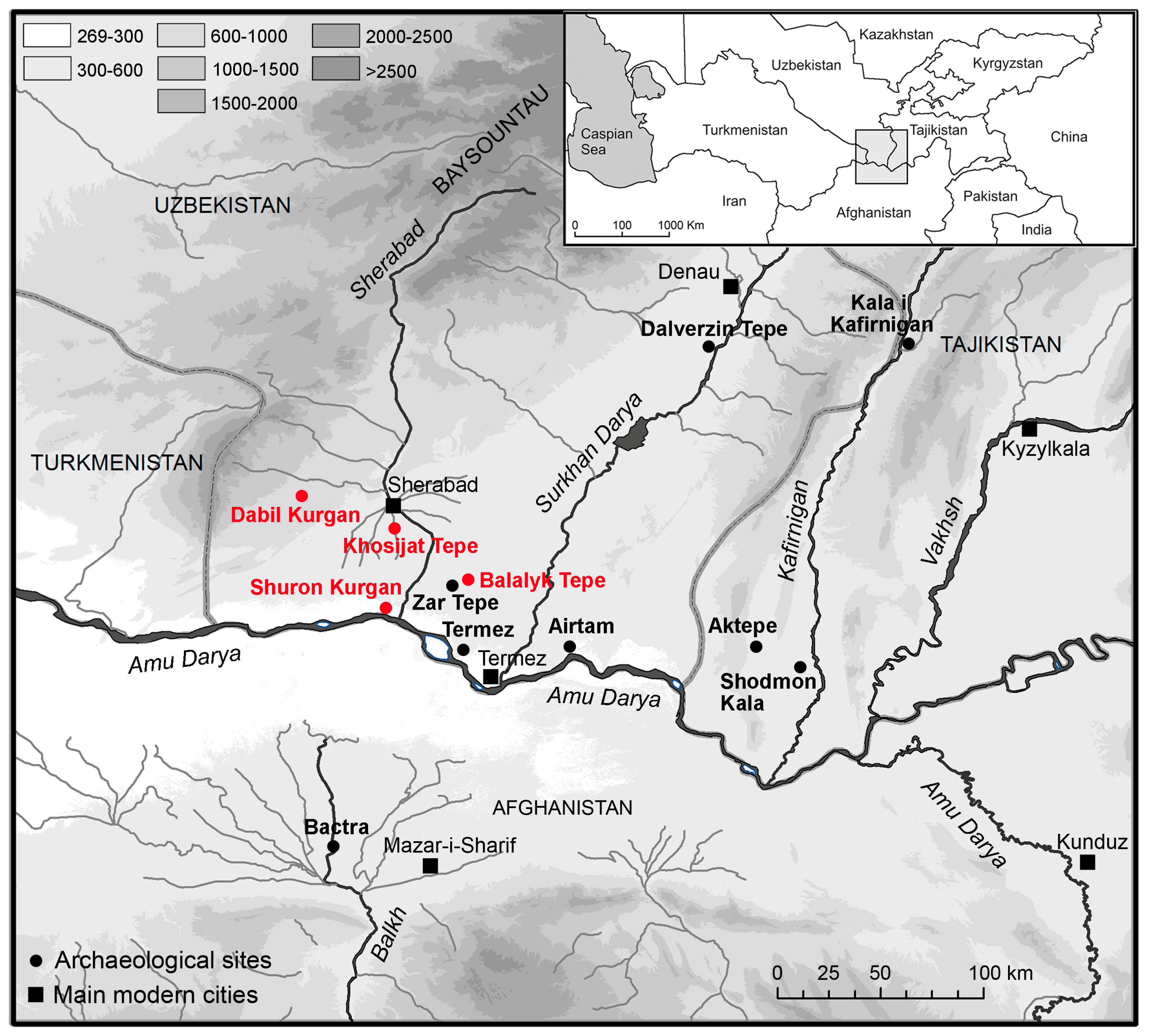

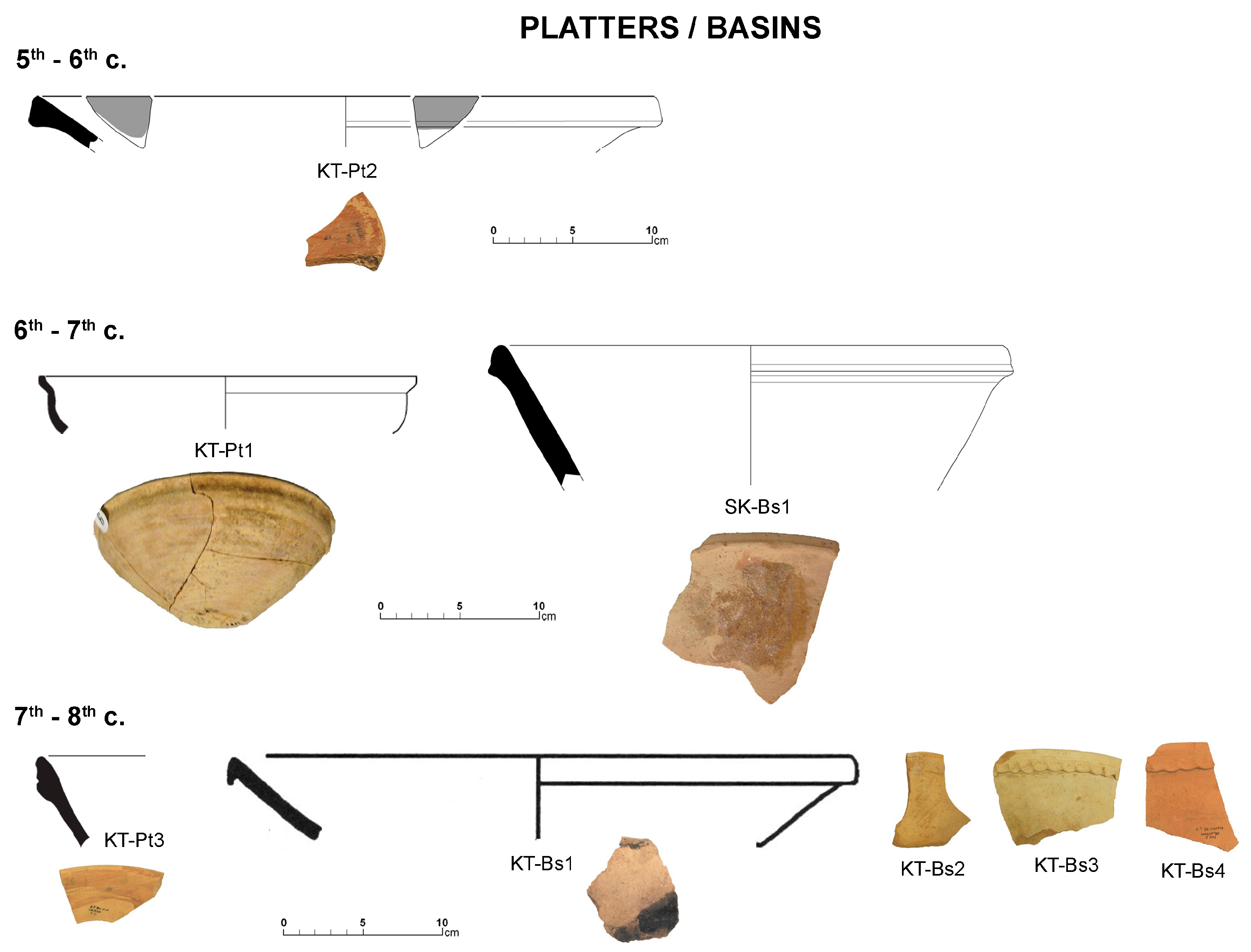
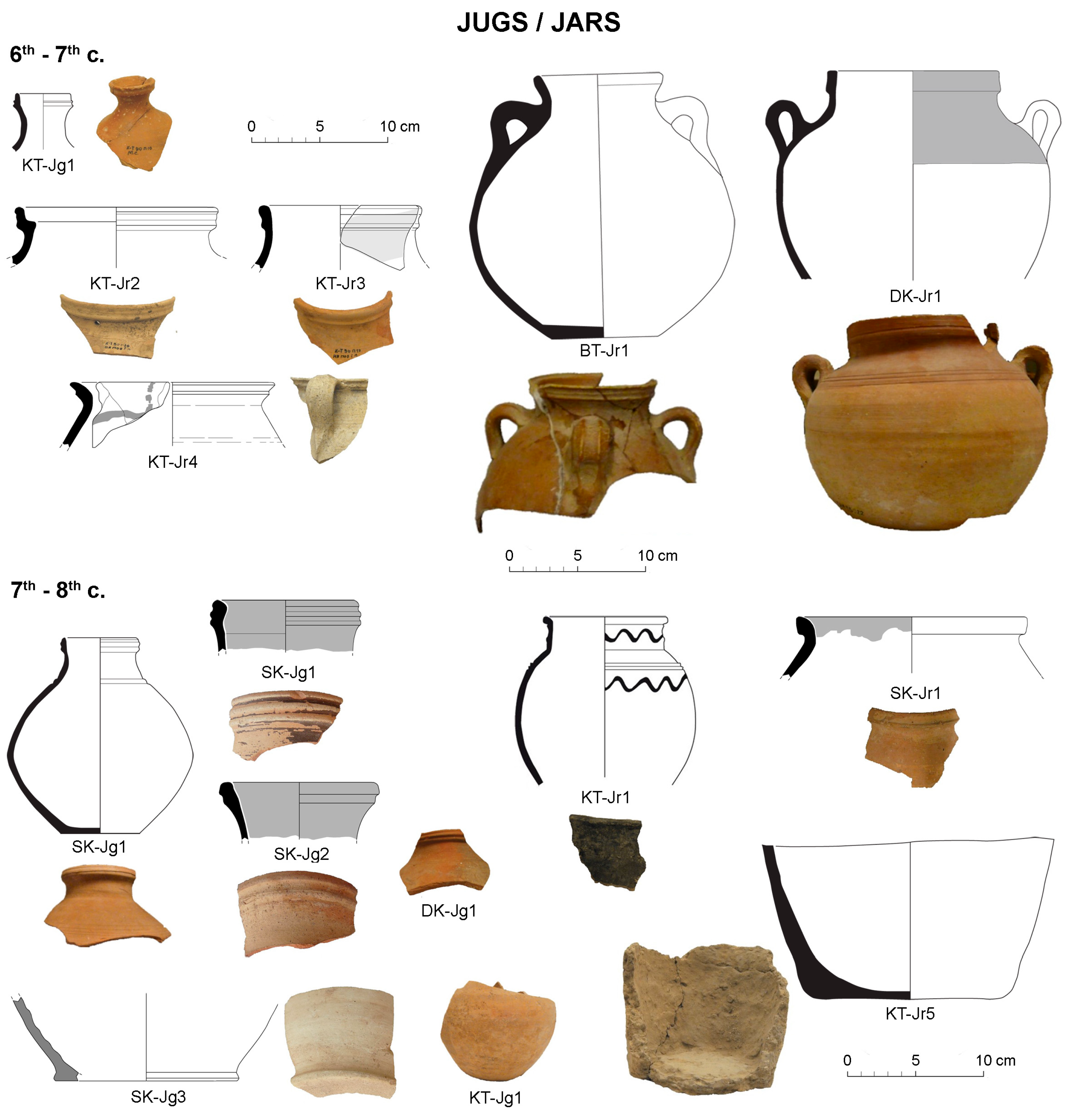
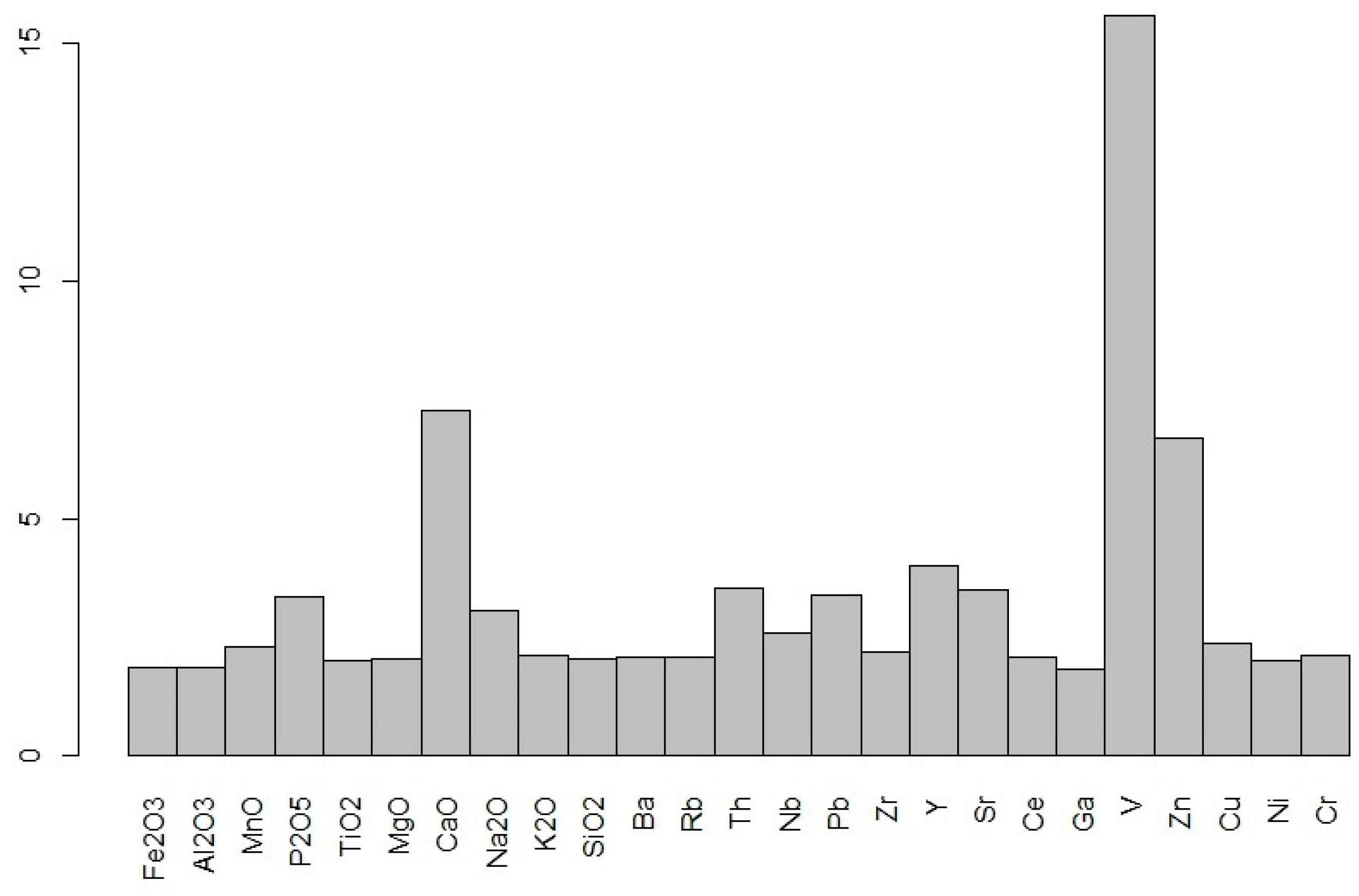
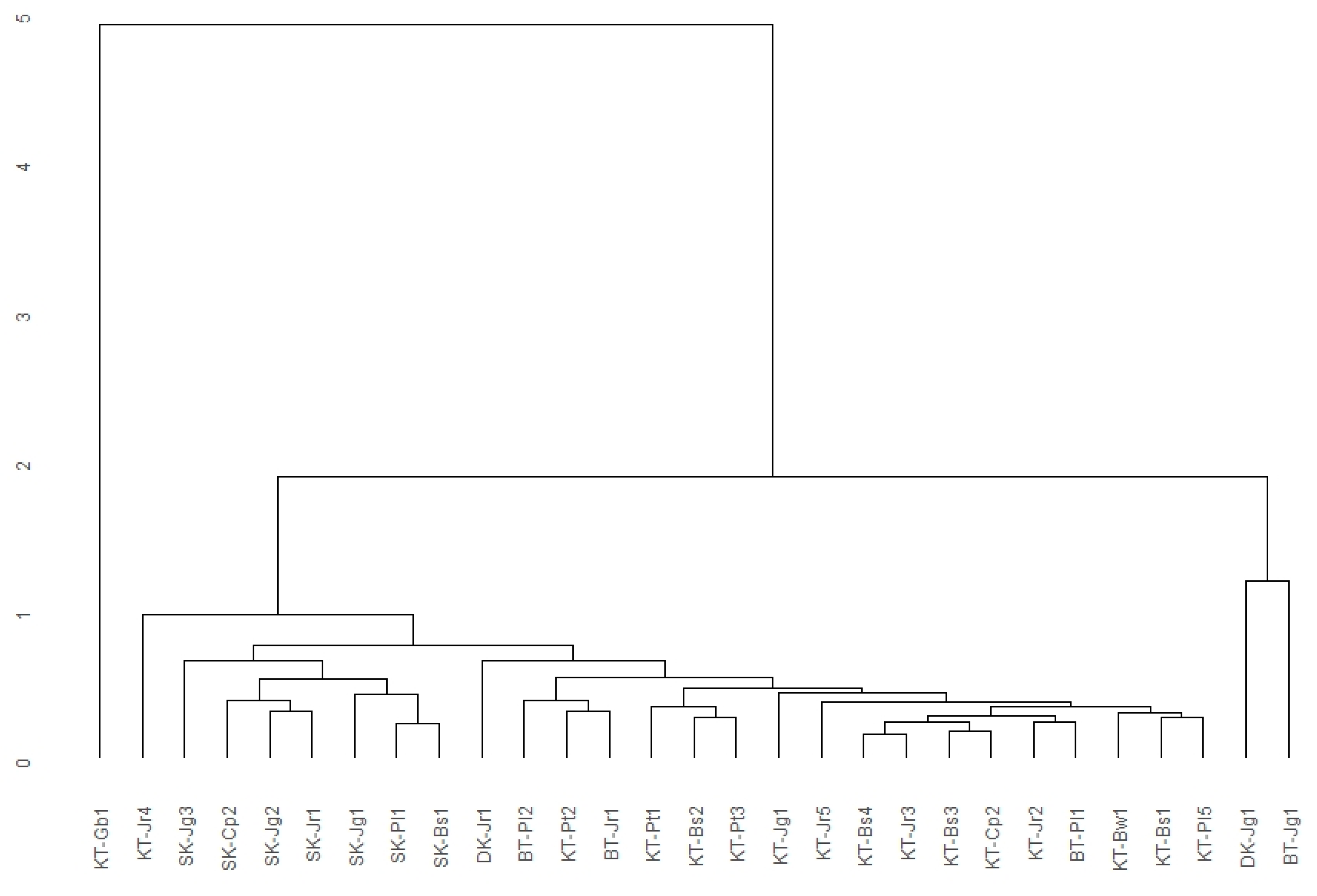

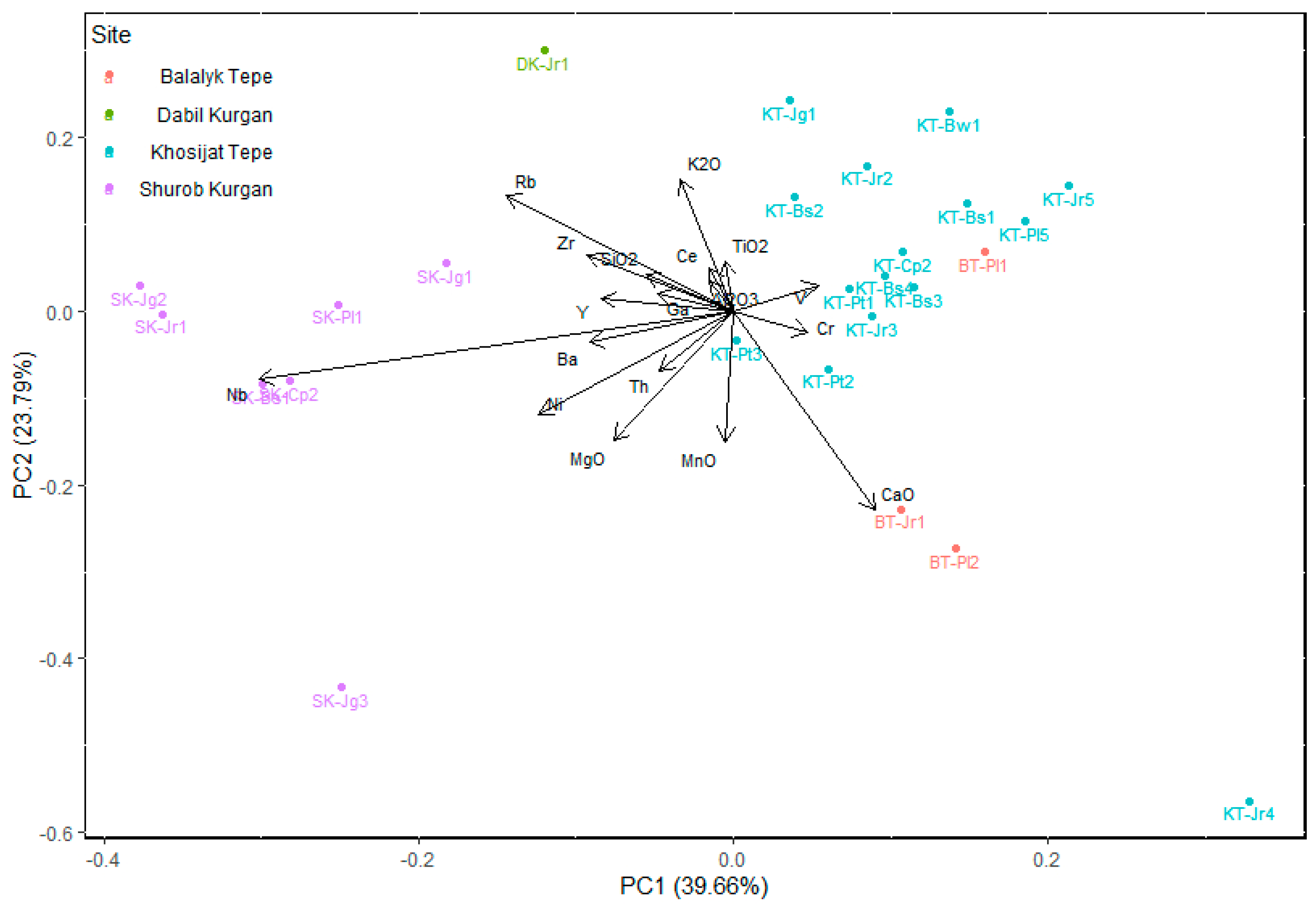
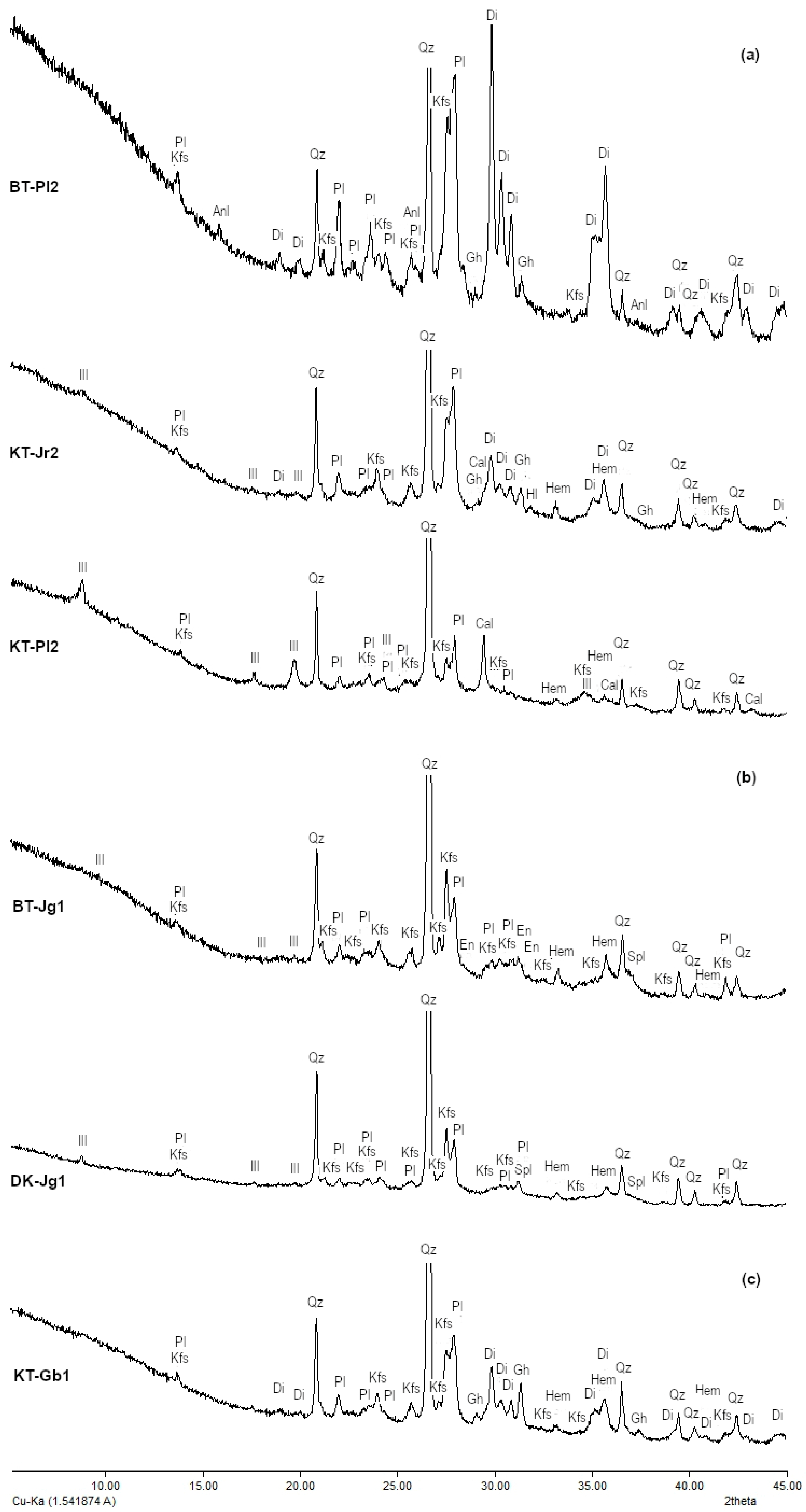
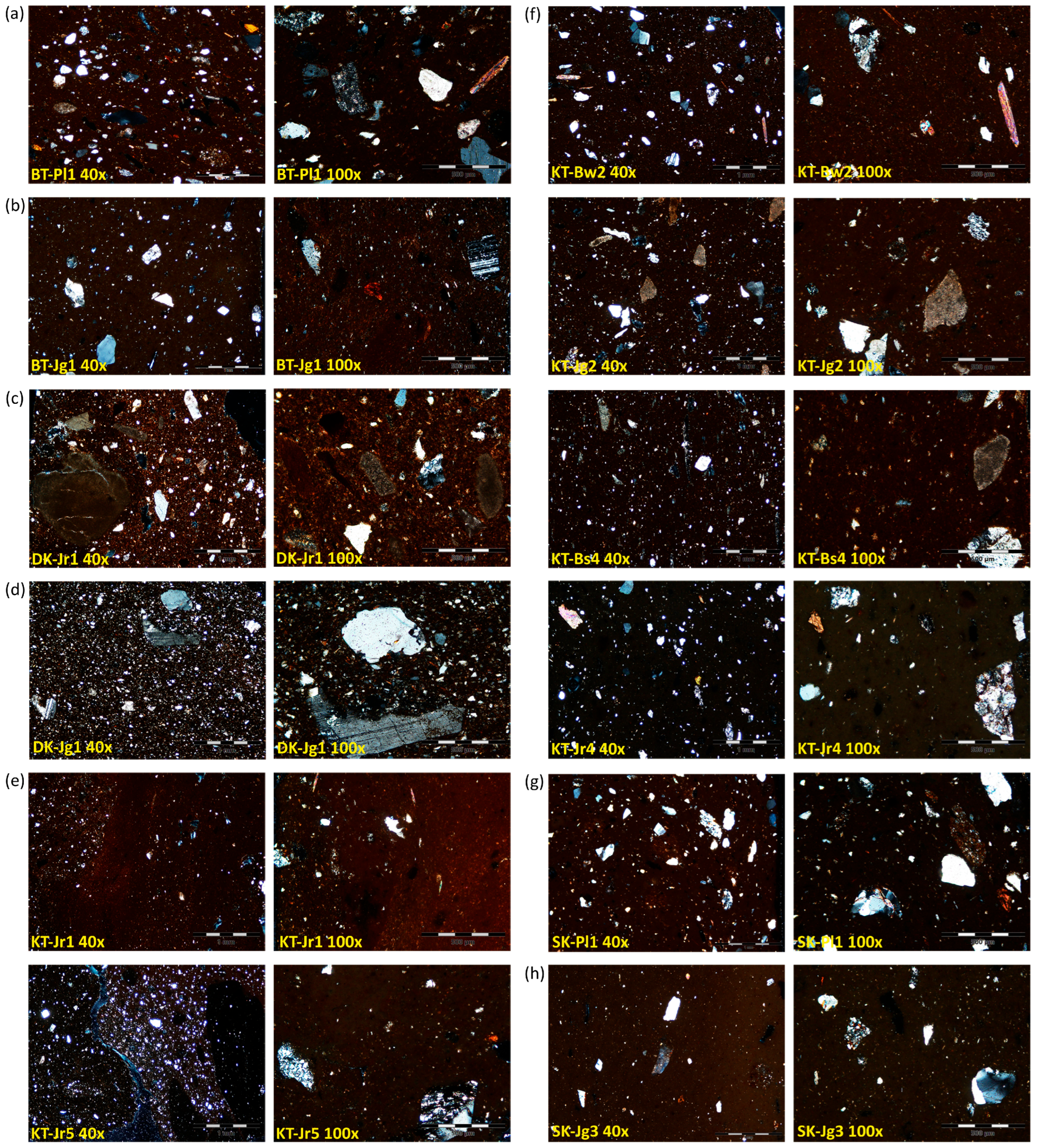
| Sample | Description and Presumed Dating | References and Parallels | Earlier Examples | Analysis |
|---|---|---|---|---|
| BT-Pl1 | Plate (6th–7th c.) Wide and shallow conical body, with vertical rim and pointed lip. Red-brown slipped in the inner and outer surfaces. | Balalyk Tepe [5] (p. 89; 60.3) Khosijat Tepe [2] (fig. 9.1) Ajina Tepe [2] (fig. 18.22) Dabil Kurgan [6] (p. 45; 5.13) | OM, XRD, XRF | |
| BT-Pl2 | Plate/bowl (6th–7th c.) Deep carinated body, with a convex lower part and a concave, flared upper part; direct rim and round lip. Red-brown slipped rim inside and outside. | Khosijat Tepe (KT-Pl1) Nameless Settlement [2] (fig. 29.25) | Tchingiz Tepe [10] (p. 24) Termez [11] (p. 295, TRZ332) Zar Tepe [12] (p. 166; 79.15) Bishkent Valley [13] (p. 175, XXVII-20) | OM, XRD, XRF |
| BT-Jr1 | Jar (6th–7th c.) Globular body with a short and narrow neck and 4 semi-circular handles placed vertically in the upper body; rim with an internal recess for a lid and external grooves. Red-brown slip on the outer surface. | Balalyk Tepe [2] (p. 91; 64) | OM, XRF | |
| BT-Jg1 | Jug (7th c.) Globular body with short, narrow neck; vertical, direct rim incised with external grooves. Non-slipped, with incised, horizontal lines in the upper body. | Shurob Kurgan [14] (p. 108, 14.6) | OM, XRD, XRF | |
| DK-Jr1 | Jar (6th–7th c.) Globular body with vertical, semi-circular handles; vertical, thickened rim, externally profiled, with a flat lip. Red-brown slip on the rim and the upper part of the body, with incised, concentric lines in the shoulder. | Dabil Kurgan [6] (p. 46; 6.10) | OM, XRD, XRF | |
| DK-Jg1 | Jug/jar (7th c.) Short, narrow neck, with vertical, thickened rim, externally profiled with grooves. Red slip and concentric, parallel incised lines in the shoulder. | Dabil Kurgan [6] (fig. 8.10) | OM, XRD, XRF | |
| KT-Cp1 | Cup/bowl (6th–7th c.) Small hemispherical body with a disc-shaped foot; slightly in-curved rim with pointed lip. Traces of dark-brown slip in the inner and outer surfaces. | Khosijat Tepe [2] (fig. 9.10) Dabil Kurgan [6] (p. 45; 5.10) Shurob Kurgan [14] (p. 112, 18.7 or 19) | Dalverzin Tepe [15] (p. 144, 100.6) Termez [16] (p. 543, 3) Tchingiz Tepe [17] (p. 31, 18) | OM, XRD |
| KT-Cp2 | Cup/bowl (6th–7th c.) Oval body, with slightly out-curved rim and pointed lip. Dark-brown slip covering the rim in the inner and outer surfaces and drips of slip in the inner surface. | Khosijat Tepe [2] (fig. 12.12) Shurob Kurgan [14] (p. 104, 10.2) | OM, XRD, XRF | |
| KT-Bw | Bowl (5th–6th c.) Deep, slightly flared body; short, slightly everted rim marked with an inflection and round lip. Red slip in the inner and outer surfaces. | Dabil Kurgan [6] (p. 45; 5.8) | Tchingiz Tepe [17] (p. 62, 21) Zar Tepe [12] (p. 163; 76.5; p. 174; 87.21; p. 188, 101.19) | OM, XRD, XRF |
| KT-Bw2 | Bowl (5th–6th c.) Hemispherical body; thickened, T-shaped rim. Red slip in the inner and outer surfaces. | Kalai Kafirnigan [2] (fig. 32a-1) | Zar Tepe [12] (p. 160, 71.7г and p. 166, 79 17) | OM, XRD |
| KT-Pl1 | Plate/bowl (6th–7th c.) Deep carinated body, with a convex lower part and a concave, flared upper part; slightly everted rim and round lip. Dark brown slipped in the inner and outer surfaces. | Balalyk Tepe (BT-Pl2) Nameless Settlement [2] (fig. 29.25) | Termez [11] (p. 295, TRZ332) Zar Tepe [12] (p. 166, 79.15) Bishkent Valley [13] (p. 175, XXVII-20) | OM, XRD |
| KT-Pl2 | Plate/bowl (6th–7th c.) Very simple hemispherical body; straight rim and pointed lip. Red-orange slipped in the inner and outer surfaces. | Khosijat Tepe [2] (fig. 9.4) Dabil Kurgan [6] (p. 51; 8.2) Shurob Kurgan [14] (p. 112, 18.7; 113, 19.5) Kuchuk Tepe [2] (fig. 6.5) Kafir Kala [2] (fig. 20.9) | Tchingiz Tepe [17] (p. 49, 39) | OM, XRD |
| KT-Pl3 | Plate/bowl (6th–7th c.) Wide conical body; rim turning upward with a pointed lip. Red slipped inside and probably outside. Soot marks in the outer surface. | Khosijat Tepe [2] (fig. 9.1) Kuchuk Tepe [2] (fig. 6.2) Shurob Kurgan [18] (p. 60, 10.6) | Zar Tepe [12] (p. 169, 82.11) | OM, XRD |
| KT-Pl4 | Plate (6th–7th c.) Wide conical body forming a sort of carina in the upper part; direct rim with round lip. Probably non-slipped. | Khosijat Tepe [2] (fig. 8.2) Balalyk Tepe [5] (p. 89, 60.3) Kafir Kala [2] (fig. 20.4) Kalai Mir [2] (fig. 30.21) Kulagly Tepe [2] (fig. 3) Ajina Tepe [2] (fig. 18.22) | Zar Tepe [12] (p. 169, 82.2) | OM, XRD |
| KT-Pl5 | Plate (7th–8th c.) Wide convex body with carinated profile; wavy rim with round lip. Red-brown slipped in the inner and outer surfaces. | Dabil Kurgan [6] (p. 61; 13.11) Shirkent [2] (fig. 38.6) | OM, XRF | |
| KT-Gb1 | Handled goblet (6th–7th c.?) Deep, convex body; direct, simple rim; ring-shaped vertical handle attached just under the rim, and decorated with parallel, longitudinal grooves. Non-slipped. | Khosijat Tepe [2] (fig. 9) Balalyk Tepe [5] (p. 89; 60.2b) Dabil Kurgan [6] (p. 45; 5.1) Kulagly Tepe [2] (fig. 3) | Bishkent Valley [13] (p. 173, XXV-10 and 11) | XRD, XRF |
| KT-Pt1 | Platter (6th–7th c.) Deep, conical body with small flat base; everted rim marked with an inflection and round lip. Non-slipped. | Khosijat Tepe [2] (fig. 9.14; 10.2) Kulagly Tepe [2] (fig. 3, 4th row, 4th profile) | OM, XRD, XRF | |
| KT-Pt2 | Platter (5th–6th c.) Conical body with flared wall; thickened rim, slightly prolonged downward. Red slip inside and outside, and burnished decoration over the inner surface. | Kuev Kurgan [2] (fig. 5.41) Shurob Kurgan [14] (p. 112, 18.16) | Dalverzin Tepe [15] (p. 157, 110.18) Zar Tepe [12] (p. 187, 100.6) | OM, XRD, XRF |
| KT-Pt3 | Platter/basin (7th–8th c.) Conical body with flared wall; straight rim marked by a protrusion/trim on its outer part, with a round lip. Painted with slip over the upper inner surface. | Dabil Kurgan [6] (p. 54; 9.10) | Aktepe II [19] (p. 185, XXIII-4) | OM, XRD, XRF |
| KT-Bs1 | Basin (7th–8th c.) Flared body, slightly carinated; sub-triangular, vertical hanging rim. Non-slipped. Soot marks on the outer surface. | Shurob Kurgan [18] (p. 57, 7.9) | Kampyr Tepe [20] (p. 62,1) Zar Tepe [12] (p. 161, 73.1б; p. 178, 91.7) | OM, XRD, XRF |
| KT-Bs2 | Basin (7th–8th c.) Flared wall; vertical, thickened rim marked by an inflection, with round lip. Non-slipped. | Shurob Kurgan [18] (p. 60, 10.9) | OM, XRD, XRF | |
| KT-Bs3 | Basin (7th–8th c.) Conical body with flared wall; straight rim marked by a protrusion/trim on its outer part decorated by digital impressions, with a round lip. Non-slipped but with a cream-coloured patina. | Khosijat Tepe [2] (fig. 13.25) Shurob Kurgan [18] (p. 57, 7.1) Khayrabad Tepe [2] (fig. 14.85) | OM, XRD, XRF | |
| KT-Bs4 | Basin (7th–8th c.) Conical body with flared wall; straight rim marked by a protrusion/trim on its outer part decorated by digital impressions, with a round lip. Non-slipped. | Khosijat Tepe [2] (fig. 13.25) Shurob Kurgan [18] (p. 57, 7.1) Khayrabad Tepe [2] (fig. 14.85) | OM, XRD, XRF | |
| KT-Jg1 | Jug (7th–8th c.) Flat base; spherical body. Non-slipped. | Khosijat Tepe [2] (fig. 12.1) Kafir Kala [2] (fig. 22.13) Shirkent [2] (fig. 38.15) Shurob Kurgan [18] (p. 59, 9.6) | OM, XRD, XRF | |
| KT-Jg2 | Jug (6th–7th c.) Globular body with narrow, short neck; small mouth with a vertical rim marked with one groove, and round lip. Red slip on the outer surface and mouth inner part. | Balalyk Tepe [5] (p. 67 or 72) Ajina Tepe [2] (fig. 18.10) Shirkent [2] (fig. 38.15) | Tchingiz Tepe [17] (p. 62, 16 or 20) Kobadian [19] (p. 194, XXXII-14) | OM, XRD |
| KT-Jr1 | Jar/pot (7th–8th c.) Hemispherical body; straight, short neck; everted, rounded rim. Neck and upper body are decorated with a wavy motif; soot marks in the outer surface and the upper inner surface. | Kafir Kala [2] (fig. 22.12?) | Ak Tepe II [19] (p. 179, XVII-3) | OM, XRD |
| KT-Jr2 | Jar (6th–7th c.) Relatively wide mouth and short neck; vertical rim with an inner ridge to accommodate a lid and outer trimming, with round lip; incised horizontal line on the shoulder. Non-slipped. | Khosijat Tepe [2] (fig. 7.20) Shurob Kurgan [18] (p. 54, 4.5) | Kara Tepe [21] (p. 39, KT28) Tchingiz Tepe [17] (p. 63, 49) | OM, XRD, XRF |
| KT-Jr3 | Jar/jug (6th–7th c.) Relatively wide mouth and short neck; vertical, thickened rim profiled with a groove and a protrusion, with a round lip; horizontal, parallel lines on the shoulder. Non-slipped. | Khosijat Tepe [2] (fig. 10.19) Shurob Kurgan [14] (p. 113, 197.6 and 7) | Zar Tepe [12] (p. 189, 102.16) | OM, XRD, XRF |
| KT-Jr4 | Jar (6th–7th c.) Relatively wide mouth and very short neck; out-turned, thickened rim with a protrusion above the junction with the neck, and a pointed lip. One or two vertical handles with longitudinal grooves attached to the upper body. It is decorated with two bands of incised horizontal lines and, between them, a band of wavy lines. Non-slipped. | Shurob Kurgan [18] (p. 54, 4.4) | Kara Tepe [21] (p. 39, KT29) Tchingiz Tepe [17] (p. 63, 52) Dalverzin Tepe [15] (p. 44) | OM, XRD, XRF |
| KT-Jr5 | Jar (7th–8th c.) Flat base; almost vertical body; thick, uneven wall. Non-slipped. | Dabil Kurgan [22] (p. 149, 7.15) Kalai Kafirnigan [2] (fig. 31.19) | OM, XRD, XRF | |
| SK-Cp1 | Cup/bowl (6th–7th c.) Small, hemispherical body with thick walls; in-turned rim with round lip. Brown-red slip on the inner and outer surfaces. | Balalyk Tepe [5] (p. 89; 60.1b) Khosijat Tepe [2] (fig. 9.10) | Zar Tepe [12] (p. 176, 89.13) Kara Tepe [21] (p. 39, KT1) Termez [11] (p. 175, 7 or 8; 193, 12). | OM |
| SK-Cp2 | Cup/bowl (6th–7th c.) Deep, conical body with thick walls; straight rim with round lip. Red slip inside and outside. | Shurob Kurgan [18] (p. 60, 10-5) Dabil Kurgan [6] (p. 45, 5.13) | Kampyr Tepe [23] (p. 739, 1, KPT9) | OM, XRD, XRF |
| SK-Pl1 | Plate/bowl (6th–7th c.) Tulip-shaped body with thick walls; almost vertical wall, rounded in the lower part; out-turned, rim with two parallel grooves on the outer side. Dark brown slip on the rim. | Shurob Kurgan [14] (p. 112, 18.6) | Bishkent Valley [13] (p. 175, XXVII-18) | OM, XRD, XRF |
| SK-Bs1 | Basin (6th–7th c.) Truncated cone shape with thick walls; straight rim marked by a protrusion/trim on its outer part, with round lip. Non-slipped. | Shurob Kurgan [18] (p. 53, 3.10) Khosijat Tepe [2] (fig. 7.10) | Aktepe II [19] (p. 185, XXIII-4) | XRD, XRF |
| SK-Jg1 | Jug (7th–8th c.) Narrow, long neck; vertical, slightly in-turned rim, trimmed on the outer surface with protrusions and grooves. Dark brown slip outside. | Shurob Kurgan [18] (p. 59, 9.10) | Tchingiz Tepe [11] (p. 384, TRZ166) Zar Tepe [12] (p. 175, 88.12) Aktepe II [19] (p. 178, XVI-13) | OM, XRD, XRF |
| SK-Jg2 | Jug (7th–8th c.) Neck diverging upward; thickened rim profiled with protrusions and a groove on the outer part. Traces of red slip on the external surface. | Dabil Kurgan [22] (p. 147, 5.23) | Zar Tepe [12] (p. 186, 99.3) | OM, XRD, XRF |
| SK-Jg3 | Base of jug or basin (7th–8th c.) Disc-shaped foot and convex body. Non-slipped. | Shurob Kurgan [14] (p. 110, 16.5) | OM, XRD, XRF | |
| SK-Jr1 | Jar (7th–8th c.) Wide mouth; very short neck; thickened triangular rim with a pointed lip, marked with an inflection. Traces of red slip on the external surface. | Shurob Kurgan [18] (p. 61, 11.12; p. 58, 8.12) Kafir Kala [2] (fig. 23.17) | Shodmon Kala [19] (p. 192, XXX-2) Aktepe II [19] (p. 182, XX-26) | OM, XRD, XRF |
| Sample | Fe2O3 | Al2O3 | MnO | P2O5 | TiO2 | MgO | CaO | Na2O | K2O | SiO2 |
|---|---|---|---|---|---|---|---|---|---|---|
| BT-Pl1 | 6.01 | 15.20 | 0.08 | 0.16 | 0.66 | 3.06 | 9.71 | 1.22 | 3.18 | 56.31 |
| BT-Pl2 | 6.25 | 15.04 | 0.10 | 0.20 | 0.68 | 3.52 | 11.68 | 2.10 | 2.74 | 55.79 |
| BT-Jr1 | 5.96 | 14.57 | 0.10 | 0.20 | 0.62 | 3.94 | 10.83 | 1.26 | 3.12 | 52.80 |
| BT-Jg1 | 7.04 | 18.22 | 0.08 | 0.20 | 0.76 | 3.31 | 2.78 | 1.60 | 4.15 | 59.71 |
| DK-Jr1 | 5.52 | 14.40 | 0.08 | 0.24 | 0.65 | 3.12 | 6.57 | 1.59 | 4.38 | 58.92 |
| DK-Jg1 | 5.77 | 14.69 | 0.05 | 0.12 | 0.79 | 2.80 | 1.24 | 1.64 | 3.35 | 68.61 |
| KT-Cp2 | 6.29 | 15.88 | 0.08 | 0.22 | 0.69 | 3.36 | 10.04 | 1.27 | 3.67 | 54.34 |
| KT-Bw1 | 6.43 | 16.24 | 0.09 | 0.24 | 0.71 | 3.18 | 7.99 | 1.10 | 3.94 | 57.07 |
| KT-Pl5 | 6.63 | 16.47 | 0.09 | 0.21 | 0.71 | 3.20 | 10.26 | 1.11 | 3.86 | 54.28 |
| KT-Gb1 | 5.64 | 14.55 | 0.09 | 0.21 | 0.66 | 2.85 | 10.54 | 1.33 | 3.42 | 58.45 |
| KT-Pt1 | 5.69 | 14.68 | 0.09 | 0.34 | 0.67 | 2.91 | 9.80 | 1.31 | 3.30 | 58.88 |
| KT-Pt2 | 6.40 | 16.11 | 0.10 | 0.26 | 0.67 | 4.00 | 9.39 | 1.12 | 3.73 | 56.82 |
| KT-Pt3 | 5.39 | 13.74 | 0.09 | 0.25 | 0.64 | 2.59 | 11.26 | 1.39 | 3.29 | 55.51 |
| KT-Bs1 | 6.57 | 16.57 | 0.10 | 0.23 | 0.74 | 3.02 | 9.54 | 1.34 | 3.64 | 56.76 |
| KT-Bs2 | 5.58 | 14.47 | 0.08 | 0.19 | 0.67 | 2.47 | 9.92 | 1.31 | 3.39 | 56.74 |
| KT-Bs3 | 6.46 | 16.12 | 0.09 | 0.47 | 0.70 | 3.13 | 11.28 | 1.04 | 3.69 | 54.50 |
| KT-Bs4 | 6.00 | 15.23 | 0.09 | 0.29 | 0.67 | 3.01 | 10.55 | 1.16 | 3.83 | 53.35 |
| KT-Jg1 | 6.22 | 16.17 | 0.09 | 0.31 | 0.73 | 2.81 | 7.86 | 1.28 | 3.79 | 59.22 |
| KT-Jr2 | 6.15 | 15.94 | 0.08 | 0.24 | 0.71 | 3.09 | 9.37 | 1.22 | 3.58 | 56.57 |
| KT-Jr3 | 6.18 | 15.53 | 0.09 | 0.22 | 0.69 | 3.18 | 10.96 | 1.10 | 3.58 | 54.47 |
| KT-Jr4 | 5.97 | 14.54 | 0.12 | 0.25 | 0.60 | 4.13 | 14.55 | 1.59 | 3.06 | 51.22 |
| KT-Jr5 | 6.09 | 16.04 | 0.08 | 0.31 | 0.72 | 2.81 | 10.98 | 1.49 | 3.57 | 54.84 |
| SK-Cp2 | 6.28 | 15.77 | 0.09 | 0.42 | 0.65 | 3.99 | 9.14 | 0.96 | 3.87 | 55.04 |
| SK-Pl1 | 5.99 | 15.59 | 0.09 | 0.22 | 0.67 | 3.16 | 9.49 | 1.37 | 3.35 | 58.29 |
| SK-Bs1 | 5.69 | 14.65 | 0.09 | 0.22 | 0.66 | 3.13 | 10.06 | 1.18 | 3.14 | 57.03 |
| SK-Jg1 | 6.22 | 15.77 | 0.09 | 0.30 | 0.66 | 3.67 | 8.33 | 1.39 | 3.50 | 57.97 |
| SK-Jg2 | 5.40 | 14.36 | 0.08 | 0.31 | 0.62 | 3.87 | 7.47 | 2.63 | 3.51 | 55.20 |
| SK-Jr1 | 5.84 | 15.47 | 0.09 | 0.28 | 0.62 | 3.48 | 7.81 | 1.37 | 3.58 | 59.40 |
| SK-Jg3 | 6.30 | 15.09 | 0.11 | 0.18 | 0.67 | 3.65 | 12.30 | 1.67 | 2.84 | 54.95 |
| Sample | Ba | Rb | Th | Nb | Pb | Zr | Y | Sr | Ce | Ga | V | Zn | Cu | Ni | Cr | LOI |
|---|---|---|---|---|---|---|---|---|---|---|---|---|---|---|---|---|
| BT-Pl1 | 450 | 119 | 14 | 10 | 21 | 148 | 24 | 238 | 56 | 19 | 118 | 88 | 26 | 40 | 82 | 4.27 |
| BT-Pl2 | 549 | 104 | 16 | 11 | 9 | 148 | 26 | 288 | 60 | 19 | 116 | 92 | 29 | 46 | 93 | 1.74 |
| BT-Jr1 | 472 | 110 | 17 | 11 | 23 | 139 | 24 | 328 | 63 | 18 | 112 | 96 | 29 | 43 | 88 | 6.41 |
| BT-Jg1 | 652 | 142 | 17 | 13 | 33 | 142 | 28 | 197 | 73 | 22 | 131 | 112 | 36 | 50 | 98 | 1.96 |
| DK-Jr1 | 459 | 115 | 15 | 11 | 25 | 169 | 25 | 230 | 59 | 18 | 106 | 92 | 22 | 37 | 77 | 4.36 |
| DK-Jg1 | 508 | 112 | 18 | 15 | 23 | 239 | 26 | 149 | 70 | 18 | 104 | 81 | 22 | 43 | 98 | 0.77 |
| KT-Cp2 | 456 | 125 | 17 | 11 | 23 | 151 | 26 | 417 | 65 | 19 | 104 | 98 | 27 | 43 | 84 | 4.00 |
| KT-Bw1 | 452 | 125 | 15 | 11 | 23 | 146 | 25 | 365 | 68 | 20 | 115 | 90 | 26 | 42 | 74 | 2.85 |
| KT-Pl5 | 459 | 129 | 16 | 11 | 26 | 152 | 26 | 263 | 58 | 20 | 118 | 92 | 26 | 42 | 85 | 3.04 |
| KT-Gb1 | 459 | 109 | 3 | 10 | 8 | 83 | 86 | 268 | 60 | 18 | 1 | 6 | 23 | 36 | 74 | 2.13 |
| KT-Pt1 | 450 | 111 | 14 | 10 | 12 | 157 | 26 | 247 | 56 | 17 | 96 | 92 | 23 | 36 | 79 | 2.19 |
| KT-Pt2 | 557 | 124 | 17 | 12 | 24 | 140 | 26 | 365 | 68 | 20 | 129 | 81 | 28 | 50 | 100 | 1.23 |
| KT-Pt3 | 467 | 109 | 15 | 11 | 21 | 161 | 26 | 303 | 63 | 17 | 95 | 85 | 22 | 34 | 69 | 5.70 |
| KT-Bs1 | 494 | 124 | 15 | 11 | 19 | 160 | 28 | 235 | 68 | 20 | 117 | 92 | 42 | 42 | 85 | 1.32 |
| KT-Bs2 | 464 | 112 | 15 | 11 | 22 | 159 | 26 | 234 | 64 | 18 | 104 | 84 | 22 | 35 | 67 | 5.05 |
| KT-Bs3 | 519 | 128 | 17 | 11 | 22 | 156 | 27 | 511 | 66 | 20 | 108 | 103 | 30 | 45 | 87 | 2.34 |
| KT-Bs4 | 471 | 115 | 15 | 11 | 23 | 154 | 26 | 341 | 58 | 19 | 114 | 95 | 24 | 41 | 76 | 5.66 |
| KT-Jg1 | 546 | 127 | 15 | 11 | 22 | 164 | 26 | 256 | 59 | 20 | 95 | 91 | 28 | 40 | 86 | 1.36 |
| KT-Jr2 | 428 | 131 | 16 | 11 | 22 | 157 | 26 | 422 | 66 | 20 | 119 | 98 | 27 | 41 | 86 | 2.90 |
| KT-Jr3 | 497 | 124 | 16 | 11 | 23 | 159 | 27 | 301 | 58 | 20 | 106 | 96 | 29 | 42 | 80 | 3.84 |
| KT-Jr4 | 417 | 75 | 16 | 10 | 20 | 125 | 23 | 516 | 52 | 18 | 107 | 92 | 26 | 42 | 88 | 3.81 |
| KT-Jr5 | 381 | 125 | 16 | 11 | 18 | 148 | 25 | 343 | 58 | 19 | 119 | 91 | 42 | 34 | 83 | 2.93 |
| SK-Cp2 | 533 | 144 | 17 | 18 | 24 | 150 | 29 | 473 | 59 | 21 | 110 | 100 | 31 | 56 | 83 | 3.61 |
| SK-Pl1 | 464 | 143 | 15 | 17 | 12 | 177 | 28 | 286 | 52 | 20 | 91 | 92 | 30 | 45 | 70 | 1.63 |
| SK-Bs1 | 473 | 134 | 15 | 17 | 23 | 179 | 29 | 385 | 51 | 19 | 95 | 88 | 29 | 44 | 67 | 4.00 |
| SK-Jg1 | 405 | 139 | 14 | 16 | 17 | 172 | 28 | 386 | 58 | 20 | 101 | 94 | 32 | 51 | 76 | 1.93 |
| SK-Jg2 | 543 | 131 | 15 | 16 | 24 | 152 | 26 | 449 | 61 | 19 | 99 | 91 | 29 | 41 | 70 | 6.37 |
| SK-Jr1 | 537 | 141 | 18 | 17 | 20 | 153 | 27 | 326 | 66 | 20 | 97 | 95 | 35 | 50 | 80 | 1.88 |
| SK-Jg3 | 556 | 120 | 20 | 19 | 20 | 163 | 29 | 270 | 60 | 20 | 91 | 101 | 46 | 59 | 72 | 2.07 |
| Samples | Mineralogical Phases | EFT |
|---|---|---|
| DK-Jr1, KT-Bs2, KT-Bw1, KT-Pl2 | Qz, Pl, Kfs, Ill, Cal, Hem | 800–850 °C |
| BT-Pl1, KT-Jr5, KT-Pt3, KT-Bs4, KT-Jg2, KT-Pl3, KT-Pl4 | Qz, Pl, Kfs, Ill, Cal, Hem, Gh, Di, (Hl) | 850–900 °C |
| SK-Cp2, SK-Bs1, SK-Jg1, SK-Jg2 | Qz, Pl, Kfs, Ill, Cal, Hem, Gh, Di, (Hl) | 900–950 °C |
| KT-Jr2, KT-Jr3, KT-Jr4, KT-Bw2 | Qz, Pl, Kfs, Ill, Cal, Hem, Gh, Di, (Hl) | 950–1000 °C |
| KT-Pt2, KT-Bs1, KT-Bs3, KT-Jr1 | Qz, Pl, Kfs, Ill, Hem, Gh, Di, (Hl) | 950–1000 °C |
| KT-Pt1, KT-Jg1, SK-Pl1, SK-Jr1 | Qz, Pl, Kfs, Hem, Gh, Di, sec. Cal | ≥1000 °C |
| KT-Cp1, KT-Cp2, KT-Pl1 | Qz, Pl, Kfs, Hem, Gh, Di | ≥1000 °C |
| BT-Pl2 | Qz, Pl, Kfs, Gh, Di, Anl | ≥1000 °C |
| SK-Jg3 | Qz, Pl, Kfs, Hem, Di | ≥1000 °C |
| DK-Jg1 | Qz, Pl, Kfs, Ill, Hem, Spl | 900–950 °C |
| BT-Jg1 | Qz, Pl, Kfs, Ill, Hem, Spl, En | 950–1000 °C |
| KT-Gb1 | Qz, Pl, Kfs, Hem, Gh, Di | ≥1000 °C |
| Fabric Group | Groundmass | Inclusions | Voids |
|---|---|---|---|
| B1 BT-Pl1, BT-Pl2, BT-Jr1 | Brownish, calcareous, moderately homogeneous (more heterogeneous in BT-Pl2), low vitrified to vitrified (in BT-Pl2) | C.F.: common (in BT-Pl1), moderately sorted, sub-angular to sub-rounded, sub-equant to elongated. *** Qz, Kfs, Pl, Grt (≤0.5 mm, finer in BT-Pl1 and BT-Jr1); * semi-decomposed Cal (micrite), Meta, Am, opaque minerals, Mca. F.F.: abundant; predominant Qz and Fsp; other: semi-decomposed carbonates, opaque minerals, Mca. | Few vughs and vesicles |
| B2 BT-Jg1 | Brownish, Fe-rich, homogeneous, semi-vitrified | C.F.: common, moderately sorted, sub-angular to sub-rounded, sub-equant to elongated. *** Qz, altered Kfs, Pl Grt (≤0.8 mm); * Meta, Am, opaque minerals, Mca, sporadic En. F.F.: abundant; predominant Qz and Fsp; other: opaque minerals, Mca. | Few vesicles |
| D1 DK-Jr1 | Brown-orangish, calcareous, moderately homogeneous, low vitrified | C.F.: common, poorly sorted, sub-angular to sub-rounded, sub-equant to elongated. *** Qz, altered Kfs, Pl (≤0.5 mm); ** carbonates (≤1.3 mm); * opaque minerals, Mca, Am, siltstone. F.F.: abundant; dominant Qz, Fsp, carbonates; few opaque minerals, Mca, Am. | Few vughs and vesicles |
| D2 DK-Jg1 | Brown-orangish, Ca-poor, moderately homogeneous, semi-vitrified | C.F.: few, poorly sorted, sub-angular to sub-rounded, sub-equant to elongated. *** Qz, Kfs, Pl, (≤0.8 mm); * opaque minerals, Mca, sedimentary grains. F.F.: very abundant; dominant Qz, Fsp, Mca, Am. | Few vughs and vesicles |
| K1A KT-Bs1, KT-Jr5 | Brownish, Ca-rich, heterogeneous (mix of Fe-rich and Ca-rich clays with different amounts of inclusions), semi-vitrified | C.F.: common, poorly sorted, sub-angular to sub-rounded, mostly elongated. *** Claystone (≤2.4 mm); ** Qz (<0.3 mm), micritic calcite with reaction rims (≤0.8 mm); * opaque minerals, chert. F.F.: common to abundant; silt and fine-sand grain-sized; predominant Qz and Fsp; common semi-decomposed carbonates, opaque minerals, Mca. | Abundant vughs and planar voids, partially filled with secondary minerals (micrite, halite) |
| K1B KT-Jr1 | Brown-reddish, heterogeneous (Fe-rich streaks and Ca-rich spots), semi-vitrified | C.F.: few, moderately sorted, sub-angular to sub-rounded. *** Qz, Kfs, Pl (≤0.4 mm); ** opaque minerals, claystone and siltstone (≤1.7 mm); * Meta. r. and semi-decomposed calcite (micrite) (<0.4 mm). F.F.: common to abundant; silt and fine-sand grain-sized; predominant Qz and Fsp, common opaque minerals, Mca. | Common elongated vughs and vesicles |
| K2A KT-Bw2 | Brown-reddish, heterogeneous with Ca-rich spots, semi-vitrified | C.F.: few to common, moderately sorted, sub-angular to sub-rounded, sub-equant to elongated. *** Qz, Pl, Kfs (≤0.5 mm); ** sandstone and silt aggregates (≤0.8 mm), semi-decomposed calcite (micrite) (≤0.8 mm); * Meta, Mca, Am, Volc, opaque minerals (≤0.5 mm). F.F.: common; predominant Qz and Fsp; other: Mca, micrite, opaque minerals, Am | Few vughs and vesicles |
| K2B KT-Cp1, KT-Cp2, KT-Bw1, KT-Pl1, KT-Pl2, KT-Pl3, KT-Pl4, KT-Pl5, KT-Pt1, KT-Pt2, KT-Pt3, KT-Bs2, KT-Bs3, KT-Bs4, KT-Jg1, KT-Jg2, KT-Jr2, KT-Jr3 | Brown to brown-orangish or brown-reddish, mixing of Fe-rich clay with Ca-rich material, moderately homogeneous, low vitrified (in KT-Cp2, KT-Bw1 and KT-Pl2) to vitrified (in KT-Pt2, KT-Jg1 and KT-Pl4) | C.F.: few to common, moderately sorted, sub-angular to sub-rounded, sub-equant to elongated. *** Qz, Pl, Kfs (≤0.5 mm); ** Meta (≤0.5 mm), semi-decomposed calcite (micrite) (up to 0.8 mm in KT-Jg2); * Mca, Am, Volc and crystals (Cpx, Ep), opaque minerals, chert. F.F.: common; predominant Qz and Fsp; other: Mca, micrite, opaque minerals, Am, Cpx. | Few to common vughs and vesicles, sometimes filled with secondary minerals (micrite and maybe gypsum?) (KT-Bs3, KT-Bs4) |
| K2C KT-Jr4 | Pale brown, Ca-rich, moderately homogeneous, fine, vitrified | C.F.: common, moderately sorted, sub-angular to sub-rounded, sub-equant to elongated. *** Meta and crystals (Qz, Kfs, Pl) (≤0.5 mm); ** claystone (≤1 mm); * Mca, Am, Cpx, carbonates, Volc. F.F.: common; predominant Qz and Fsp; other: Mca, micrite, opaque minerals, Am. | Few vughs and vesicles, sometimes filled with secondary minerals (halite) |
| S1A SK-Jg2, SK-Jr1 | Brownish, Fe-rich with Ca-nodules, fine, moderately homogeneous, semi-vitrified | C.F.: common, poorly sorted, sub-angular to sub-rounded, sub-equant to elongated. *** Qz, Pl, Kfs (≤0.8 mm); ** Meta, semi-decomposed carbonates (micrite); * Mca, Am, Vol, Cpx, opaque minerals, sandstone. F.F.: common; predominant Qz, Fsp, Mca; sporadic Am and opaque minerals. | Few vughs and vesicles |
| S1B SK-Cp1, SK-Pl1, SK-Jg1 | Brownish, Fe-rich with Ca-nodules, fine, moderately homogeneous, semi-vitrified to vitrified | C.F.: common, moderately sorted, sub-angular to sub-rounded, sub-equant. *** Qz, Pl, Kfs (≤0.5 mm); ** Meta; * opaque minerals, Mca, semi-decomposed carbonates (micrite) (up to 1.35 mm in SK-Pl1), Am, sandstone; sporadic Cpx, Ep, Srp and Volc. F.F.: common; predominant Qz, Fsp, semi-decomposed carbonates, opaque minerals, Mca. | Few to common vughs and vesicles |
| S1C SK-Cp2 | Brown-orangish, Fe-rich, fine, heterogeneous, semi-vitrified | C.F.: few, moderately sorted, sub-angular to sub-rounded, sub-equant. *** Qz, Pl, Kfs (≤0.5 mm); ** Meta; * opaque minerals, Mca, semi-decomposed carbonates (micrite); sporadic Cpx, Ep, Srp and Volc. F.F.: common; predominant Qz, Fsp, semi-decomposed carbonates, opaque minerals, Mca. | Few vughs and vesicles |
| S2 SK-Jg3 | Brownish, Ca-rich, very fine, moderately homogeneous, vitrified | C.F.: few, moderately sorted, sub-angular to sub-rounded, sub-equant to elongated. *** Qz, Pl, Kfs and Meta (≤0.4 mm); ** opaque minerals; * Mca, Am, Volc. F.F.: common; predominant Qz, Fsp, Mca, semi-decomposed carbonates; sporadic Am and opaque minerals. | Few vughs, vesicles and channels |
Disclaimer/Publisher’s Note: The statements, opinions and data contained in all publications are solely those of the individual author(s) and contributor(s) and not of MDPI and/or the editor(s). MDPI and/or the editor(s) disclaim responsibility for any injury to people or property resulting from any ideas, methods, instructions or products referred to in the content. |
© 2025 by the authors. Licensee MDPI, Basel, Switzerland. This article is an open access article distributed under the terms and conditions of the Creative Commons Attribution (CC BY) license (https://creativecommons.org/licenses/by/4.0/).
Share and Cite
Bestetti, M.M.; Martínez Ferreras, V.; Esparraguera, J.M.G. Multidisciplinary Approach to the Study of Tableware and Common Wares from Early Medieval Tokharistan. Heritage 2025, 8, 65. https://doi.org/10.3390/heritage8020065
Bestetti MM, Martínez Ferreras V, Esparraguera JMG. Multidisciplinary Approach to the Study of Tableware and Common Wares from Early Medieval Tokharistan. Heritage. 2025; 8(2):65. https://doi.org/10.3390/heritage8020065
Chicago/Turabian StyleBestetti, Maura M., Verónica Martínez Ferreras, and Josep M. Gurt Esparraguera. 2025. "Multidisciplinary Approach to the Study of Tableware and Common Wares from Early Medieval Tokharistan" Heritage 8, no. 2: 65. https://doi.org/10.3390/heritage8020065
APA StyleBestetti, M. M., Martínez Ferreras, V., & Esparraguera, J. M. G. (2025). Multidisciplinary Approach to the Study of Tableware and Common Wares from Early Medieval Tokharistan. Heritage, 8(2), 65. https://doi.org/10.3390/heritage8020065






